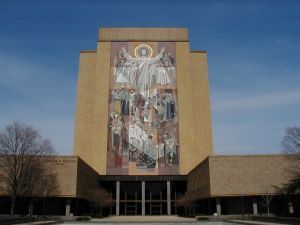Migratory tribes lived in Indiana as early as 8000 BC. By 900 AD, their numbers had reached 30,000. Then their entire civilization suddenly disappeared, the reason a mystery even today.
The first Europeans entered the area in the 1670s representing France. The territory flipped hands a number of times. At the end of the French and Indian War and 100 years of French dominance, it fell to Great Britain. However, only 20 years later – at the end of the Revolutionary War – it transferred to the United States. Indiana was admitted to the Union as the 19th state in 1846.
The state today is a fascinating mix of an industrial and an agricultural economy, punctuated by the fame of the NFL’s Indianapolis Colts, the NBA’s Indiana Pacers and the Indianapolis 500 race. South Bend is also home to an undisputed football powerhouse, the University of Notre Dame.
According to 50states.com, the state’s motto, “Cross Roads of America,” is apt. Indiana claims more miles of interstate highway per square mile than any of the other 49 states. The motto dates to the early 1800s, when river traffic along the Ohio River was a major method of transportation. More major highways currently intersect in Indiana than in any other state. At one time, 12 different stage coach lines ran through the state over the National Road, which is now Interstate 40.
Indiana is in many ways a study in contrasts. Although its name means “Land of the Indians,” at present, fewer than 8,000 Native Americans reside in the state. More than 100 species of trees are known to be native to Indiana. However, while 80 percent of the state was considered forest before the pioneers arrived, today only 17 percent is deemed forested.
While the state’s Lake Michigan shoreline is a mere 40 miles long, Indiana is still considered a Great Lakes State. And although Illinois generally claims to be the home of Abraham Lincoln, he moved to Indian when he was just 7 and spent most of his boyhood living in Spencer County.
During the Civil War, the farming community of Fountain City in Wayne County was referred to as the Grand Central Station of the Underground Railroad. Residents provided overnight lodging for more than 2,000 runaway slaves heading for freedom in Canada.
The big-city atmosphere of the capital, Indianapolis, contrasts with the pace of life in many Amish and Mennonite settlements in the northeastern part of the state. The time line dividing Eastern and Central time zones actually lies near Indianapolis, so the state operates under two time zones.
Much of the country’s industrial development came from Indiana despite its farming regions. During World War II, the P-47 fighter airplane was manufactured in Evansville. Marcella Gruelle of Indianapolis created the Raggedy Ann doll in 1914. Crawfordsville has been dubbed the home of the only known working rotary jail in the United States. Now a museum, it housed a rotating cellblock constructed in 1882.
The Studebaker Company of South Bend was once the largest producer of horse-drawn wagons in the country. It then morphed into an automobile manufacturer. The world’s first practical gasoline pump was invented in Fort Wayne by Syvanus F. Bower. And Indianapolis grocer Gilbert Van Camp brought us an old family recipe for pork and beans.
Contributions from the Ball Corporation, manufacturer of glass canning jars, were the primary source of funding for Ball State University in Muncie. Santa Claus, Indiana receives more than half a million letters and requests during each Christmas season. Terre Haute was home to the American Federation of Labor, founded in 1881. The Saturday Evening Post is published in Indianapolis.
The granddaddy of the present Indianapolis 500 was an auto race held May 30, 1911 at the Indianapolis Motor Speedway. The winner averaged 75 miles per hour and won a purse of $14,000. This contrasts with a current $1.2 million first prize and an average speed of more than 167 miles per hour.
Residents of Indiana are called Hoosiers. There are dozens of folklore origins of the word, but no official explanation of its derivation. The state has scores of famous natives and residents. TV host David Letterman hailed from Indianapolis, while 1930s gangster John Dillinger managed to escape from the Lake County Jail in Crown Point using a wooden pistol. Indiana claims to have been the home one President and five Vice Presidents. Indiana’s poet laureate, James Whitcomb Riley, was born in a two-room log cabin in Greenfield.
Other famous Hoosiers include entertainers Leon Ames, Anne Baxter, James Dean, Phil Harris, Michael Jackson, Buck Jones, Red Skelton and Forrest Tucker. Carole Lombard, Shelley Long, Marjorie Main and James McCracken all called it home. Basketball great Larry Bird came from French Lick, and journalist Ernie Pyle hailed from Dana. Other residents who became well-known public figures included lawyer Wendell Wilkie, explorers Lewis and Clark and writers Jessamyn West, Kurt Vonnegut and Booth Tarkington.
Reference:
- 50states.com web site



